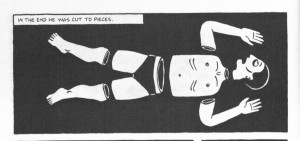Hi everyone!
For the past few weeks, my ASTU 100 class has been reading the graphic narrative Persepolis, written by Marjane Satrapi. It tells the life of Marji (Satrapi’s younger self), growing up in Iran during the time of the Islamic Revolution and the Iran-Iraq War. Told through the eyes of a child, this graphic narrative shows Marji’s personal struggles as it illustrates the political turmoil and violence within Iran during that time. While being in comic book style, the images within Persepolis are devoid of unnecessary details and are coloured with only black and white; unlike what you would expect for a comic book.
Despite Persepolis being filled to the brim with emotions (Marji’s anger towards the regime and anguish when her uncle Anoosh is executed) Satrapi chooses to omit colour, which conveys emotions from the book. Why does she do this? Is it because she feels that the emotions held within the book are impossible to convey with just words and colour?
With just black and white colouring the images and the simplistic art of the illustrations, Satrapi tells the story of her childhood through Marji’s perspective on her world that is wrought full of complex violence and turmoil. It is through the simple artwork that Satrapi juxtaposes Marji’s innocent and naïve outlook with the true horror and the normalcy of the violence that is surrounding her. This shows up when two of her family’s friends were released from prison and are telling Marji’s parents about what happened to another prisoner. They tell that he was tortured more than they were and ultimately, “was cut into pieces” (52). When Marji hears of this, she immediately imagines the body cleanly cut and hollow, while in truth a cut up body looks nothing that.
The man cut up into pieces “cannot be adequately illustrated by words-or by pictures-from the perspective of either children or adults” (Chute 102) and it is here we see the juxtaposition between Marji’s innocent views and the horrors that are happening around her.
Works cited:
Satrapi, Marjane Satrapi. Persepolis: The Story of a Childhood. New York: Random House, 2003. Print
Chute, Hillary. “The Texture of Retracing in Marjane Satrapi’s Persepolis.” Women’s Studies Quarterly 36.1&2 (Spring/Summer 2008): 92-110. Web. JSTOR. 7July 2015.
Image:
https://satrapism.files.wordpress.com/2011/04/kic0000013.jpg
